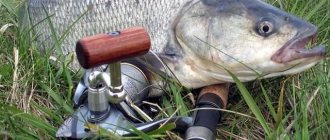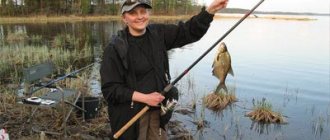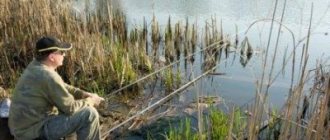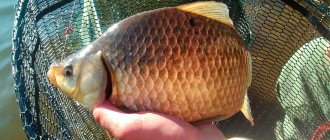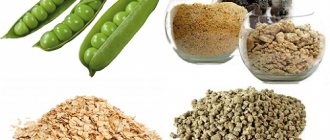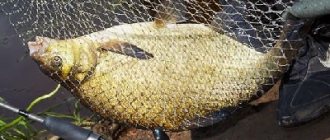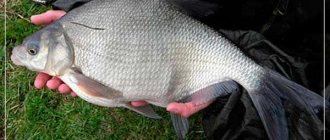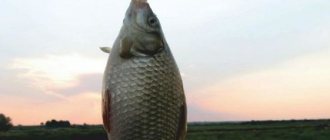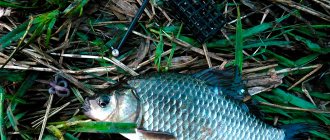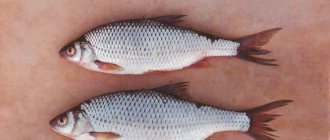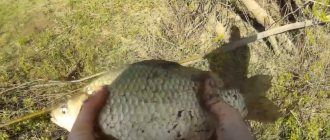Where is crucian carp found in spring?
With the arrival of spring warmth, the inhabitants of reservoirs emerge from hibernation. But for now they still prefer to stay close to wintering pits; this period falls in March-April and the crucian carp is just beginning to be active.
As the water column warms up in May, the activity of crucian carp increases, and feeding grounds expand. The zone of interest includes shallow water heated by the sun. Coastal thickets and overhanging branches from which bugs and spiders fall onto the surface of rivers and ponds.
Crucian carp, gathering in schools, begin to circle around the reservoir, following the food base.
It can often be found in shallows and spits.
In spring, crucian carp rubs in shallow water areas
With the appearance of the first vegetation, fish “graze” in coastal areas.
Oxbow lakes and backwaters with little current are promising fishing grounds.
Air bubbles rising from the bottom indicate the movement routes of fish rummaging through the mud.
The pre-spawning period is characterized by the activity of crucian carp and occurs in the middle and end of spring. In central Russia - May. At this time, crucian carp feeds near future spawning sites: at the mouths of quiet rivers. Before entering heated bays and channels up to 3 meters deep. “Windows” in aquatic vegetation are also attractive to crucian carp.
Crucian carp biting calendar - with warming in March-April, the first phase of crucian activity begins
Fishing for bream in March on a feeder
The first rays of the sun, life-giving oxygen, falling through the thickness of the ice into the layers of water, awakens the bream dormant in the depths. The fish begin to leave their homes, moving into shallow water in search of food.
White fish move in flocks, choosing coastal areas where they can find food. As the air temperature rises and the snow melts, the fish's metabolic processes accelerate, and this pushes the bream to move closer to the surface of the reservoir.
The organization of fishing depends on the behavior of the bream and its habits in a particular reservoir. Weather conditions and water conditions affect the catch:
- Warming up the water leads to the appearance of bream in shallow water near the shore.
- When the air temperature reaches plus ten degrees, it is easier to catch fish in holes four to five meters deep.
- Considering the wariness of bream and the transparency of March water, fishing gear is chosen to be less noticeable.
- Although the fish is hungry, it does not suffer from gluttony, and you should not overfeed it. In some cases, large specimens are caught even without bait. It is important to throw the tackle in the place where a school of bream migrates.
- To bait the fish in advance, food is poured into the holes gradually over a week.
- The most catchy tackle in March for large bream is considered to be a feeder.
When fishing for bream in March, it is important to accurately cast the tackle. And when biting, be able to maintain composure and bring the bream to the surface, allowing it to take a breath of fresh air. Then he will surrender without resistance.
Features of spring feeder bait
The seemingly simple task of feeding crucian carp has its own nuances when fishing in a pond.
Fishermen distinguish crucian carp reservoirs in which the number of “golden” crucian carp exceeds the population of other species. And ordinary ones, where “bast shoes” do not dominate.
In the second case, the composition of the bait is important. Should not be attractive to your table neighbors.
The basis of bait when catching crucian carp on a feeder in late spring (April-May) is made up of various porridges: peas, steamed pearl barley, steamed millet; when fishing in early spring (April), you need to add animal components to the bait - bloodworms, worms, maggots.
Interesting. Added drinking yogurt does not attract other underwater inhabitants and stimulates the crucian's appetite.
In early spring, it is recommended to mix in animal ingredients: bloodworms, maggots and worms. At this time, the crucian carp is “putting on fat.”
It is important not to overfeed the crucian carp. Otherwise, having eaten enough, he will lose interest in the bait.
When catching crucian carp on a feeder in the current, creating a feeding zone, the balls must be sticky. So that they do not immediately crumble when hitting water, but are gradually washed out. Good “adhesion” is provided by clay and soil from molehills.
Creating a feeding spot
At the same time, on muddy soil, a dense lump will fall into a soft cushion without fulfilling its function.
Features of bait for March bream
As was said, you need to feed the fish just enough so that it does not become even more sluggish and does not go to depth. It is necessary to add to the bait the type of bait that is used (chopped worm, maggots, caster), mixing them with a vegetable additive of pearl barley, peas or corn (but not with sunflower seeds).
To prevent the bait from being quickly washed out by the current, it is better to make it more inert by adding a little clay, river silt or soil to the feed. In any case, the impact of the water flow cannot be avoided, so you need to throw it in approximately one place. In addition, the color of the feeder itself should blend in with the ground as much as possible, so study the area where you will be fishing in advance.
Read how to make bait for feeder fishing with your own hands for different fishing conditions.
To summarize, it should be noted that even after following all our advice, you may find yourself in a situation where the atmospheric pressure changes or the wind increases, which will negatively affect the bite. However, the chances increase significantly when you go prepared, with an understanding of what awaits you.
Baits and baits used
The protein component is preferable when the inhabitants of reservoirs emerge from hibernation; for catching crucian carp they use:
- earthworm and dungworm;
- maggots and bloodworms (in “crucian carp” ponds);
- crawl pieces;
- caddisfly
Maggot and worm sandwich
When the crucian carp tastes the first greenery (usually in May), vegetable baits are recommended:
- peas;
- boiled pearl barley;
- bread crumb;
- cake.
Flavorings include sweet smells: garlic, cocoa, raspberry, anise.
When rolling dough or bread crumbs, you can pre-smear your hands with Vietnamese “Star”.
“Golden” crucian carp becomes active when the water warms up to 10-12 degrees.
They catch crucian carp in the spring using different gear: a classic float, a Bolognese fishing rod, and even a spinning rod.
Feeder fishing, as an advanced type of bottom tackle, is also relevant. Having calculated the movement routes of crucian carp, food traps are created.
Roach fishing conditions and season
There is probably no more fun and rewarding fishing than catching roach on a spring river. Somewhere from mid-April to the first days of May, depending on the weather, the spring run of roach begins. During this period, it is caught using bottom gear, even with the most primitive baits, but roach takes it much better on the feeder.
And this is understandable: the leash with the hook and bait is in the stream of washed-out bait. And no matter how much the fish is in a hurry to get to the spawning grounds, when they come across grains of aromatic bait, and then a brush of dung worms, how can they resist? Grab it!.. And at that moment the fisherman on the shore begins to nod and twitch the quivertip of the feeder, and the bell on the rod rattles. It's time to hook! And there a red-eyed fish is already splashing in the fast stream, splashing silver splashes on the sides and bending the feeder rod. The spring roach can be especially large and strong. If we talk about the Volga, then it is the Volga soroga that rises along small rivers to the upper reaches, weighing up to a kilogram or more.
Everything would be fine, and spring time is the most fertile time without mosquitoes and midges, and the spring weather excites the soul and warms the blood, and fishing can be exciting and rewarding, but, as always, there is a “but”... The course of the roach is different for each specific chosen place happens short-term. And it’s not always possible to get exactly two or three days of the spring movement. True, if the weather is unstable, with clear days changing to gray and rainy ones, then sometimes the roach’s course is delayed. She walks and then stops, waiting out the bad weather.
Where to catch roach? It has been noticed that the “fish path” runs in the river in places where the current is a little weaker. This is understandable: the fish needs to conserve its strength, because the path to the upper reaches of the river is still long. Also, the roach tries to choose a route along some underwater hollows and along the edge of a flooded willow forest, even if it is located next to the newly formed shore. Often it is along this edge that the slope to depth is located. Such places can be very successful for feeder fishing.
The roach becomes more active, and its movement becomes massive when the water temperature is at least 10-15 degrees. And the fish bite also increases when the water gets warmer. Therefore, on cold days, often with snow, the fish just stands there, does not rise upstream and refuses any bait or bait.
Collection of feeder gear for catching spring crucian carp
The characteristics of the reservoir and the behavior of its inhabitants are taken into account.
It is recommended to catch low-active crucian carp using balanced delicate equipment, thin fishing lines and small hooks. Then, as the fish become interested, they switch to self-hooking rigs with strong cords and leashes.
Rod
A fishing rod with a length of 2.7-3.6 meters is selected depending on the fishing conditions: the presence of a current, casting distance, location of coastal and coastal vegetation.
The test form varies between 30-80 g. Large guide rings and removable quivertypes are recommended.
The structure of the rod should show good information in still water and in the current.
Coil
As a rule, when fishing with feeder gear, a reel is taken in size from 2000-2500 with low sides for unhindered line escape. Transmission mechanism with a value not higher than 1:4. With the ability to get prey and a feeder. The recommended number of bearings is 4-6, a well-adjustable friction brake. For beginner feeders, equipment with a baitrunner is desirable.
fishing line
Braid is preferable for the following reasons:
- low-stretch, sensitive to bites;
- thin and durable, less “sails” in the underwater flow.
Diameter: 0.14-0.18 mm.
Feeder collection trough
Selected weighing around 40-60 grams. Early spring fishing for crucian carp with a feeder involves casting into shallow water, so feeders are used
insignificant in weight. This type of gear creates less noise when falling into the water.
When fishing in the current, a rectangular or triangular shape is recommended. This will reduce the likelihood of moving along the bottom.
Also, for additional fixation on the ground, wire “whiskers” are used, which keep the tackle from tipping over.
The installation of the feeder should provide a good visual start to the bite and not scare away the crucian carp; the following types of installation are used:
- Symmetrical loop . It is made with a diameter of 25-30 cm from monofilament with a thickness of 0.25-0.27 mm. In this case, the feeder moves freely along the string. The downside of the rig is the likelihood of overlap with the leash.
- Asymmetrical loop . The same material and dimensions of the cord, but the leash is separated from the main loop by a braided “pigtail”. This design minimizes overlaps.
- Gardner rig (Paternoster) . It is considered a classic in feeder fishing. Installation involves placing the leash above the food. Convenient when casting onto a muddy bottom, when the “table” is recessed and the bait is located higher.
installations
Feeder designs:
- Open . The lower and upper parts are not equipped with partitions. When it hits the bottom, the bait quickly spreads out. They are used to create a feeding zone and in standing water.
- Semi-closed. The lower end is made with perforation, which leads to gradual leaching of the composition in the underwater flow and the formation of a stern plume.
- "Springs" Made in the form of a spiral. Light in weight, used for fishing in ponds, lakes and reservoirs with weak currents.
Spring feeder - often used for feeder fishing for crucian carp
Leash
Designed to save the main line from losing the entire equipment.
Interesting. Crucian carp is a cautious fish, so when choosing a leash, this feature is taken into account. The more timid the prey, the longer the lead.
For feeder fishing, a piece of 50-60 cm of monofilament with a thickness of 0.14-0.16 mm is considered optimal.
Hooks
Selected depending on the bait or attachment:
- No. 14-8 for vegetation (peas, pearl barley, corn, bread crumb);
- No. 10-6 with long or medium shank for earthworm;
- No. 14-10 are suitable for maggots;
- No. 16-14 bloodworms are attached.
What equipment is needed for feeder fishing in cold water?
Dmitry Zimarev uses sliding editing. The movement of the feeder is limited by a stopper and a knot.
In March, the fish are still sluggish like winter, even on the lower Moscow River, so Dmitry recommends using a long leash - up to 1.5 m.
This leash allows you to:
- the bait sinks more naturally, attracting still sluggish fish. The bite often occurs in the water column.
- a long leash allows the fish to take the bait more confidently without feeling the rig.
- in the spring in March, as a rule, the current on the rivers is strong, and the bait from the feeder feeder is carried at a decent distance. And a longer leash allows the bait with a hook to be among the bait particles.
Tactics for catching crucian carp on a feeder in spring
Having chosen a fishing spot, they begin to examine the bottom using the “tapping” method. For this purpose, a marker weight is used that is identical in weight to the filled feeder.
The cast is performed in front of you (0 degree angle) to the maximum possible distance. After the load reaches the bottom, the rod drags the marker 1.5-2 meters, bringing the tip of the form to an angle of 45-90 degrees from the original, maintaining a horizontal plane.
Watch the tip and listen to the sensations “in your hand”:
- tapping indicates a rocky area;
- tight movement is possible on clay, silt;
- smooth stretch - sand.
After pulling and reeling in the line, make a sharp vertical jerk with the rod. The weight in the water is thrown up (without coming to the surface) and counting begins. Ends when reaching the bottom marker. Then the next dragging, etc. This is how the depths are measured.
Important. Count down the same way every time. Experienced fishermen use the fastest possible one, in which there are no pauses.
By changing the casting location and distance, the topography and structure of the bottom are determined.
The catch point is planned. It is convenient to “fix” the direction according to the landmark on the opposite side.
A feeding zone is first created, for this purpose the bait is sent to the selected place 10-15 times.
The feeder is filled with food, bait is placed on the hook, and the gear is cast.
The distance is fixed by clipping the fishing line.
The rod is installed on the stand, raising the tip as much as possible. This is necessary when fishing in the current so that the line touches the water and the sail as little as possible.
It remains to monitor the behavior of the quivertype. The hooking is not done sharply, because the crucian carp has a thin lip.
Fishing for crucian carp in the spring on a feeder - video report:
Spring fishing is varied. As the action progresses, gear and bait change. Various tactics are used. This is a test of the readiness of the equipment and the fisherman for the upcoming season.
Where to catch bream on a feeder in March
Choose a place for catching March bream on a feeder where there are:
- channel edges near the shore;
- bays with fresh water;
- bottom tables with a depth of two to four meters;
- bends of the bottom channel;
- pools in the tributaries of the river.
In such places, the whitefish awaits food and a lot of oxygen. You should go for your catch in the morning, as soon as the sun rises. Sometimes large specimens are caught in the afternoon, but not for long.
It is better to go for the evening bite when dusk appears. They feed the marked places in advance at a depth of four to six meters. Good luck awaits patient hunters, but after two in the morning you are unlikely to get a bite.
The presence of bream in a reservoir is determined by the catch of fishermen sitting on the shore. Don’t think that bream is afraid of crowds of fishermen. If at least one person guesses the course of the fish and catches several specimens of bream, then the neighbors will be lucky too. After all, the caught specimens show where the fish are concentrated.
It is interesting that, despite the shallow depth of the channels, the catch in them is greater than in large reservoirs.

